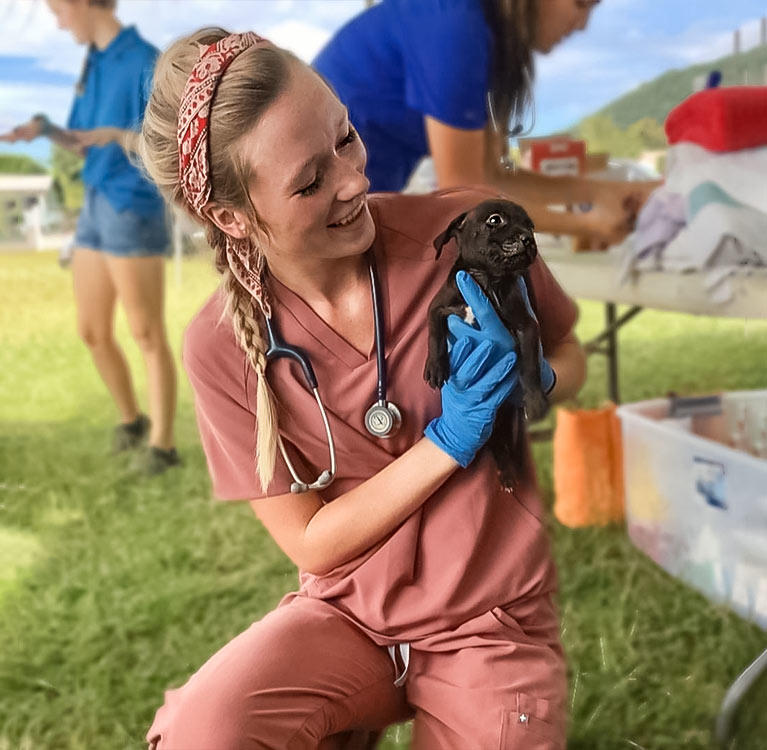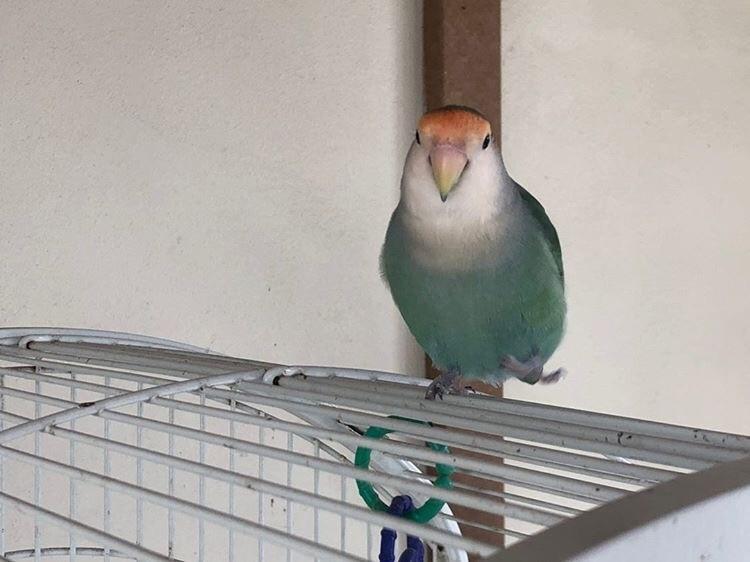You’ve almost made it. You can see the finish line and your goal of becoming a veterinarian is within reach. You’ve completed your vet school requirements, gained acceptance to a Doctor of Veterinary Medicine (DVM) program like the one at Ross University School of Veterinary School (Ross Vet), survived your preclinical courses, and now you're nearly done with your clinical year experience. So then what? The last remaining hurdle is passing the North American Veterinary Licensing Examination® (NAVLE®).
Taking the NAVLE exam is a critical milestone in your journey- passing the exam is required for licensure to practice veterinary medicine throughout the United States and Canada. At Ross Vet, we know how important this exam is and dedicate a course in the seventh semester of preclinical studies to help you prepare and practice to take computer-based veterinary licensing exams.
So, while it’s normal to feel nervous, preparing well and having solid expectations can help set you up for success. This guide of frequently asked questions (FAQs) will help you with many of the things you need to know about the NAVLE, including what is on it, how long it lasts, and what happens if you fail? (Don’t worry, you’ll get another chance!)
What to Know About the NAVLE Exam
The NAVLE Exam is administered to fourth-year veterinary students by the International Council for Veterinary Assessment (ICVA) during two testing windows each year. The exam is designed to test the knowledge of a veterinarian who is about to enter their first year of clinical practice. You can view ICVA’s FAQ page here.
Test Format: How Many Questions Are on the NAVLE?
The NAVLE is administered via computer and has 360 multiple choice questions divided into 6 sections containing 60 questions each. Of those 360 questions, 60 are considered “pre-test” questions that are not scored. But you will not know which are the “pre-test” questions because they will be mixed in with other questions. In other words, your score will derive from a set of 300 graded answers.
NAVLE Species Breakdown
You will hear the phrase “common things happen commonly” many times throughout your veterinary journey. Keep this in mind when preparing for the NAVLE exam and deciding where to focus your studies. The ICVA NAVLE summary shows the breakdown of NAVLE questions by species—exactly one half of the test involves dogs and cats, for example—which is helpful when planning your studies.
NAVLE Exam Competencies Breakdown
Remember, the NAVLE exam is designed to ensure that you are ready for your first year of clinical practice. This is reflected by the breakdown of questions based on competencies:
- Clinical practice: 70 percent
- Communication: 8 percent
- Professionalism, practice, management, and wellness: 7 percent
- Preventative medicine and animal welfare: 15 percent
Time Allowed and Breaks
You will have 65 minutes to complete each section of 60 questions—a total of 6.5 hours for all 6 sections! But don’t worry, you will have 45 minutes of break time to use however you want between the sections.
When is the NAVLE Exam?
The NAVLE Exam is offered in April and during the months of November and December each year. Students typically sit for the exam in the final year of veterinary school before graduation.
Where is The NAVLE Offered?
The NAVLE Exam is administered by Prometric, which has locations throughout the United States and Canada. The NAVLE exam is also available to international students in certain locations around the world.
Common Questions About the NAVLE Exam
How is the NAVLE Scored?
The NAVLE is scored on a scale from 200 to 800 with a minimum passing score of 425. According to ICVA, “The passing score is developed using a content-based, or criterion-referenced standard setting procedure. Members of a committee composed of veterinarians representing the various content areas covered by the NAVLE work individually and collectively to determine the minimum score that a candidate has to achieve in order to be judged minimally competent to enter private clinical practice.”
ICVA also describes the complex process through which scoring is calculated. “The passing standard is approved by ICVA, and is applied to each form of the NAVLE using a procedure called equating. Equating ensures that the passing standard remains constant in spite of minor variations in item difficulty from one form of the NAVLE to another. Raw NAVLE scores (the number of items that candidates answer correctly) are converted to scaled scores and the scaled scores are reported to licensing boards and candidates.”
When Will I Get My NAVLE Scores?
Your NAVLE scores will not be available instantly. Although it may be a test of patience, you will receive your scores via a web portal about one month after the testing window is complete (a window of two months, for example, if you take the test during November or December). This means that if you took your test earlier in the testing window, you may have to wait a bit longer for results.
What Does My NAVLE Score Mean?
Your NAVLE score report will include three sections: a pass/ fail report, your actual score, and a diagnostic report that shows your performance by topic breakdown. If you see a “PASS,” congratulations! If you see a “FAIL,” read below for tips on retaking the exam.
How Do I Prepare for the NAVLE Exam?
If you want to know how to prepare for NAVLE, you may have already started! Your veterinary education prepares you for the test. Your professors will tip you off on some of the common questions and topics that show up on the NAVLE. Despite this, you will want to give yourself plenty of time for additional preparations.
Think about which testing window best fits your study needs and schedule. The majority of successful NAVLE takers say that the best way to prepare for the test is to take practice questions and assessments. By taking practice tests, you can figure out your strengths and weaknesses and adjust your study regimen accordingly.
Two exam preparation services offer a wealth of NAVLE practice questions and assessments. Zuku Review and VetPrep are tools for NAVLE practice questions and review materials. In addition, ICVA has practice assessments and a NAVLE tutorial to help you prepare for the exam.
What If I Don’t Pass the First Time?
Don’t panic! The NAVLE is likely the most difficult exam a veterinarian will take. It’s a long exam that covers many topics, so it’s natural that not everyone will pass on their first try.
If you do not pass, give yourself enough time to adequately prepare for the next testing window. Look at your NAVLE score report which includes a diagnostic breakdown of your performance on each section. Use this to identify which topics might need more attention next time.
To improve your test taking strategy, don’t jump to answer questions and try to think out each question thoroughly. And as for your study strategy, take notes as you answer practice questions, study in short sessions, form a study group, and make charts or visual aids. In short, do whatever helps you best retain information. Most importantly, do not get discouraged! It is not uncommon for people to take the NAVLE more than once, and passing it after multiple attempts will not affect your ability to practice veterinary medicine.
How Many Times Can I Take the NAVLE?
You may take the test up to five times within a five-year period after your first try, and your attempts are limited to once per NAVLE testing window. If you sign up for the November/ December window and don’t pass, you can take the NAVLE again the following April.
How Do I Get Licensed in Another State?
When you take the NAVLE, you select which state board of veterinary medicine you want to receive your NAVLE scores. You can send your score to different state boards by going to the American Association of Veterinary State Boards (AAVSB).
How Much Does the NAVLE Cost?
The cost to take the NAVLE exam for the 2021-2022 testing cycle is $705.
I Passed the NAVLE, Now What?
Congratulations! You are one step closer to being able to practice veterinary medicine in the United States and Canada. The last step is to pass your individual state or province licensing exam. Check out the AVMA directory of state board websites to make sure you follow all state licensing guidelines.
Will Ross University School of Veterinary Medicine Prepare Me for the NAVLE?
Yes! Ross Vet has a long history of preparing veterinary students for passing the NAVLE. An education at Ross Vet can teach you the necessary tools to pass the NAVLE exam and be ready for your career. Learn more about the Ross Vet DVM program by requesting info, and start your journey in veterinary medicine today!
Related resources:






